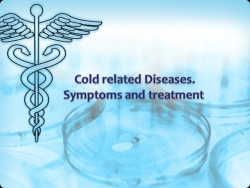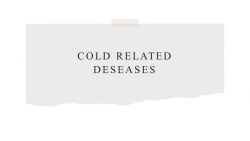Презентация на тему " Cold related deseases 1"

- Рубрика: Презентации / Другие презентации
- Просмотров: 0
Презентация для классов "Презентация на тему " Cold related deseases 1"" онлайн бесплатно на сайте электронных школьных презентаций uchebniki.org.ua
Disease
Influenza
There are four types of influenza virus, termed influenza viruses A, B, C, and D. Aquatic birds are the primary source of Influenza A virus (IAV), which is also widespread in various mammals, including humans and pigs. Influenza B virus (IBV) and Influenza C virus (ICV) primarily infect humans, and Influenza D virus (IDV) is found in cattle and pigs. IAV and IBV circulate in humans and cause seasonal epidemics, and ICV causes a mild infection, primarily in children. IDV can infect humans but is not known to cause illness. In humans, influenza viruses are primarily transmitted through respiratory droplets produced from coughing and sneezing. Transmission through aerosols and intermediate objects and surfaces contaminated by the virus also occur.
Symptoms
Symptoms range from mild to severe and often include fever, runny nose, sore throat, muscle pain, headache, coughing, and fatigue. These symptoms typically begin 1–2 days and less typically 3-4 days after exposure to the virus and last for about 2–8 days. Diarrhea and vomiting can occur, particularly in children. Influenza may progress to pneumonia, which can be caused by the virus or by a subsequent bacterial infection. Other complications of infection include acute respiratory distress syndrome, meningitis, encephalitis, and worsening of pre-existing health problems such as asthma and cardiovascular disease.
Treatment
Frequent hand washing and covering one's mouth and nose when coughing and sneezing reduce transmission. Annual vaccination can help to provide protection against influenza. Influenza viruses, particularly IAV, evolve quickly, so flu vaccines are updated regularly to match which influenza strains are in circulation. Vaccines currently in use provide protection against IAV subtypes H1N1 and H3N2 and one or two IBV subtypes.
The disease can be treated with supportive measures and, in severe cases, with antiviral drugs such as oseltamivir. In healthy individuals, influenza is typically self-limiting and rarely fatal, but it can be deadly in high risk groups.
Laboratory diagnostics
Influenza infection is diagnosed with laboratory methods such as antibody or antigen tests and a polymerase chain reaction (PCR) to identify viral nucleic acid.
Disease
Viral hepatitis
Viral hepatitis is liver inflammation due to a viral infection. It may present in acute form as a recent infection with relatively rapid onset, or in chronic form.
The most common causes of viral hepatitis are the five unrelated hepatotropic viruses hepatitis A, B, C, D, and E. Other viruses can also cause liver inflammation, including cytomegalovirus, Epstein-Barr virus, and yellow fever. There also have been scores of recorded cases of viral hepatitis caused by herpes simplex virus.
Symptoms
15% of sufferers may experience continuous or relapsing symptoms from six months to a year following initial diagnosis, a constantly present feeling of heaviness in the right hypochondrium, intense itching of the skin;
yellowness on the skin and mucous membranes; feces become light, and urine - dark; the patient loses appetite, but nausea is always present; recurrent pain in the anatomical location of the liver.
Treatment
Hepatitis A and hepatitis B can be prevented by vaccination. Effective treatments for hepatitis C are available but costly. Strict personal hygiene and the avoidance of raw and unpeeled foods can help prevent an infection. People with hepatitis A are advised to rest, stay hydrated and avoid alcohol.
There are eight treatment options approved by the U.S. Food and Drug Administration (FDA) available for persons with a chronic hepatitis B infection: alpha-interferon, pegylated interferon, adefovir, entecavir, telbivudine, lamivudine, tenofovir disoproxil and tenofovir alafenamide with a 65% rate of sustained response.
Laboratory diagnostics
blood examination,(Hepatitis B surface antigen (HBsAg), В (anti-HBs), HBcAg.
Disease
Chiken pox
Chicken pox- is an infection caused by the varicella-zoster virus. Is highly contagious to people who haven't had the disease or been vaccinated against it. Today, a vaccine is available that protects children against chickenpox. Routine vaccination is recommended by the U.S. Centers for Disease Control and Prevention (CDC).
Symptoms
The itchy blister rash caused by chickenpox infection appears 10 to 21 days after exposure to the virus and usually lasts about five to 10 days. Other signs and symptoms, which may appear one to two days before the rash, include: Fever, Loss of appetite, Headache, Tiredness and a general feeling of being unwell (malaise)
Treatment
Prevention The chickenpox (varicella) vaccine is the best way to prevent chickenpox, - sparing bed rest,
- a diet rich in proteins, complex carbohydrates, fiber and poor simple carbohydrates (sugars),
- drug treatment prescribed by an infectious disease doctor.
Important constant access to fresh air in the room, hygiene measures, rules of use in the article on atopic, and physical decrease in body temperature.
Laboratory diagnostics
BLOOD ANALYSIS (LEUKOPENIA, NEUTROPENIA, RELATIVE LYMPHOCYTOSIS, MOTOCYTOSIS, APPEARANCE OF PLASMACITES, ESR.
Disease
Fever, also referred to as pyrexia, is defined as having a temperature above the normal range due to an increase in the body's temperature set point.
Fever
Symptoms
A fever is usually accompanied by sickness behavior, which consists of lethargy, depression, loss of appetite, sleepiness, hyperalgesia, and the inability to concentrate. Sleeping with a fever can often cause intense or confusing nightmares, commonly called "fever dreams”. Mild to severe delirium (which can also cause hallucinations) may also present itself during high fevers.
Treatment
Rest and drink plenty of fluids. Medication isn't needed. Call the doctor if the fever is accompanied by a severe headache, stiff neck, shortness of breath, or other unusual signs or symptoms.
Disease
Bronchitis is inflammation of the bronchi (large and medium-sized airways) in the lungs that causes coughing
Bronchitis
Symptoms
A cough that is frequent and produces mucus.
A lack of energy.
A wheezing sound when breathing (may or may not be present).
A fever (may or may not be present).
Shortness of breath.
Treatment
One form of prevention is to avoid smoking and other lung irritants. Frequent hand washing may also be protective. Treatment for acute bronchitis usually involves rest, paracetamol (acetaminophen), and NSAIDs to help with the fever. Cough medicine has little support for its use, and is not recommended in children under the age of six. There is tentative evidence that salbutamol may be useful in treating wheezing; however, it may result in nervousness and tremors .Antibiotics should generally not be used. An exception is when acute bronchitis is due to pertussis. Tentative evidence supports honey and pelargonium to help with symptoms. Getting plenty of rest and drinking enough fluids are often recommended as well.
Disease
Pneumonia
Pneumonia is an inflammatory condition of the lung primarily affecting the small air sacs known as alveoli
Pneumonia is usually caused by infection with viruses or bacteria, and less commonly by other microorganisms
Symptoms
a cough – which may be dry, or produce thick yellow, green, brown or blood-stained mucus (phlegm)
difficulty breathing – your breathing may be rapid and shallow, and you may feel breathless, even when resting
rapid heartbeat
high temperature
feeling generally unwell
sweating and shivering
loss of appetite
chest pain – which gets worse when breathing or coughing
Treatment
Getting plenty of rest
taking antibiotics if the pneumonia is likely to be caused by a bacterial infection
drinking plenty of fluids



























